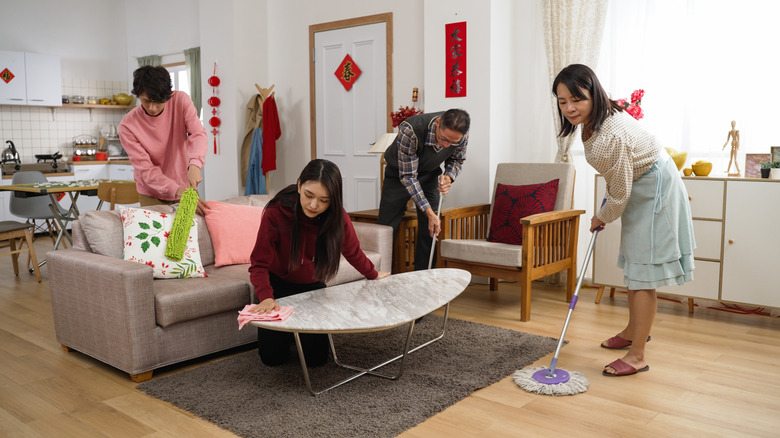Why 'Staddag' Cleaning Is 2025's Marie Kondo Alternative Trend
Marie Kondo taught the world to ask whether a sweater "sparks joy," but in 2025, many households are swapping that once-in-a-while declutter for Sweden's weekly städdag ("cleaning day"). It's been gaining traction as 2025's breakout trend. Here's why: Instead of combing through every closet at once, städdag asks everyone in the home to spend a strict window (often under two hours) vacuuming, wiping, and resetting shared spaces together. The communal sprint cuts the drip-feed anxiety that creeps in when clutter lingers into Monday. Plus, this technique can help to keep stress in check when cleaning.
Städdag's rise aligns perfectly with #CleanTok's fascination with routine. Videos showcasing communal cleaning playlists and satisfying post-tidying coffee breaks rack up views precisely because they frame housekeeping as a collective ritual rather than a solitary chore. Rooted in Sweden, a country known for its long, dark winters spent mostly indoors, städdag promotes a mindset of keeping one's home consistently guest-ready. Yet its appeal is global: a cleaner space and guilt-free Sundays resonate universally.
How städdag differs from Swedish death cleaning (and why it matters)
At first glance, both städdag and Swedish death cleaning promise a lighter, calmer home. But it's important to not conflate these two Swedish cleaning methods, even if the latter can be translated into something less morbid. In fact, they serve very different purposes. Städdag is a weekly ritual aimed at managing everyday clutter, while death cleaning (döstädning) involves a deeper, once-in-a-lifetime decluttering to ease the burden of your possessions on loved ones in the future. In a previous exclusive interview with House Digest, Professional death cleaner Katarina Blom describes it as an emotional inventory that compels individuals to confront their attachments and mortality — an intense process that städdag intentionally avoids.
The recurring nature of städdag provides consistent psychological benefits: smaller messes don't escalate, and household members learn shared responsibility. Conversely, death cleaning seeks finality; its power in decisively letting go of accumulated possessions. Practically, this means incorporating städdag to maintain weekly order, complemented by occasional death cleaning sessions for significant belongings. Treating them as complementary, rather than competing approaches, keeps your home manageable today and considerate toward the future.
Your quick-start guide to a successful städdag
Choose a day that works for you and set a visible timer. Mornings often work best. Clearly divide rooms or tasks so everyone has ownership. Try a cleaning playlists for children to stay engaged. Keep tasks manageable and achievable in one session: clear counters, vacuum floors, fold laundry. The goal isn't spotless perfection, but a functional reset in order to truly relax during the rest of the week.
Establish a reward ritual to reinforce the habit. Maybe follow it up with another Swedish tradition, like fika — a cozy break with drinks and a snack as a way to catch up, usually incorporating visits to or with friends and family. Or come up with a reward ritual that makes sense: if solo, treat yourself; if a group, treat yourselves. If motivation wanes, adopt minimalist strategies like using only one cleaning tool at a time to reduce stress. For smaller tidying routines between städdags, explore some simple yet effective home cleaning hacks.
Repeat weekly, and soon städdag will be second nature. By morning, you'll feel the quiet satisfaction of stepping into an already-organized space. It's a mindset Marie Kondo herself would celebrate, achieved not by a single major purge, but through the cumulative power of consistent, minor resets.


